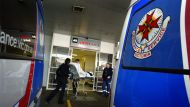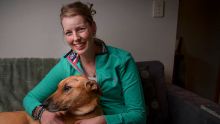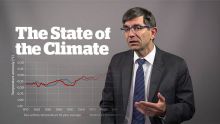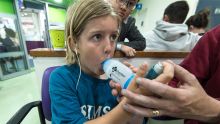A sixth person has died from thunderstorm asthma after an outbreak struck Melbourne last Monday.
Health Minister Jill Hennessy confirmed the death of a sixth victim on Saturday night.
More National News Videos
Thunderstorm asthma: sixth person dies
A sixth victim has died following the extraordinary Melbourne weather event. (Video courtesy ABC News 24)
Ms Hennessy declined to reveal any personal details about the latest victim. However, it is understood the death occurred in the intensive care unit at one of the hospitals in the Eastern Health network.
Victims of the asthma thunderstorm include 20-year-old law student Hope Carnevali and Greenvale high-school student Omar Moujalled.
Ms Carnevali died in her family's arms on their front lawn after waiting more than 30 minutes for an ambulance.
Noble Park father-of-two, Clarence Leo, and 35-year-old man, Apollo Papadopoulos, died after suffering asthma attacks, also believed to be due to the deadly weather event.
A fifth victim, believed to be a woman, died at the Northern Hospital in Epping on Friday night. A statement from the hospital confirmed the death was "a result of thunderstorm asthma which led to other medical complications".
The Department of Health and Human Services has confirmed that five patients are still in intensive care units in various Melbourne hospitals.

An additional 12 are being treated for respiratory and other related conditions, while dozens of others have been released from hospital since Friday.
Thunderstorm asthma can occur when storms follow days with high pollen counts, causing particles of pollen that are normally too big to enter human airways to explode. This releases tiny allergen particles which, when inhaled, can trigger asthma attacks.
Monday's asthma thunderstorm is the fourth to strike the city. It follows similar epidemics in November 1987 and November 1989. Another event occurred in 2011.
Monday's event triggered more than 1900 calls to Ambulance Victoria that night. Throughout Monday and Tuesday, hospitals were swamped, with 8500 patients suffering from asthma-related conditions.
Fairfax Media has revealed that most Melbourne hospitals did not follow the state's health emergency plan during the unprecedented outbreak last week, despite Ms Hennessy likening its impact to 150 bombs going off across Melbourne.
While the Department of Health says it activated the State Health Emergency Response Plan on Monday about 8pm, and that "all hospitals quickly activated their emergency response systems", only three hospitals told Fairfax Media that they called a Code Brown consistent with the plan on Monday night.
These hospitals were Geelong, which called one at 7pm, the Austin which called one at 10:10pm and St Vincent's which called one at 11:36pm. The Northern Hospital in Epping called one on Tuesday about 7:30am.
The State Health Emergency Response Plan says: "When hospitals and health services respond to an external emergency, they will activate their Code Brown plan… Code Brown plans provide the additional capacity that hospitals need to receive an influx of patients."
The plan also says: "Once notified of an incident, hospital Code Brown response plans will be activated as the whole health service prepares to manage an influx of patients."
Ms Hennessy has asked the Inspector-General of Emergency Management to review how well the crisis was handled by April 2017. Opposition health spokeswoman Mary Wooldridge said the review should be expedited to ensure the community could trust the state's emergency management plans.
With Daniella Miletic
Follow Aimee Amiga on Twitter.














